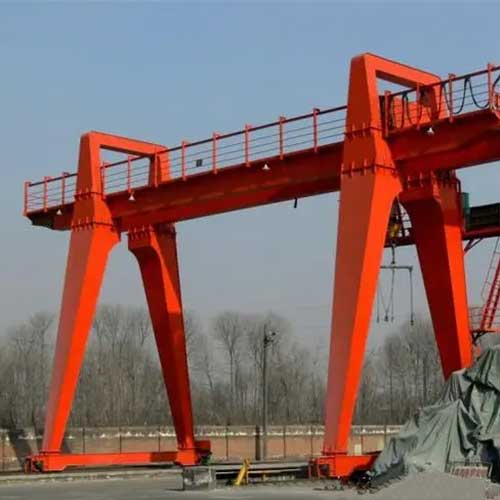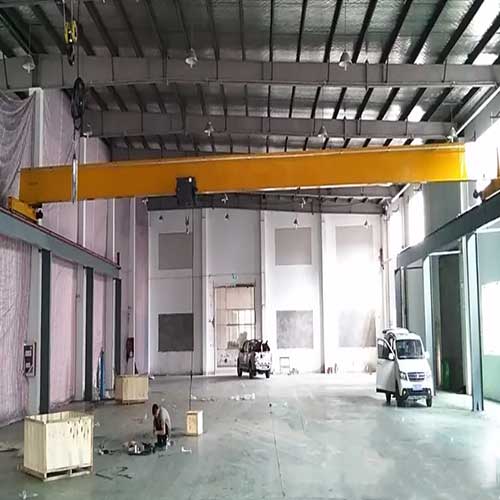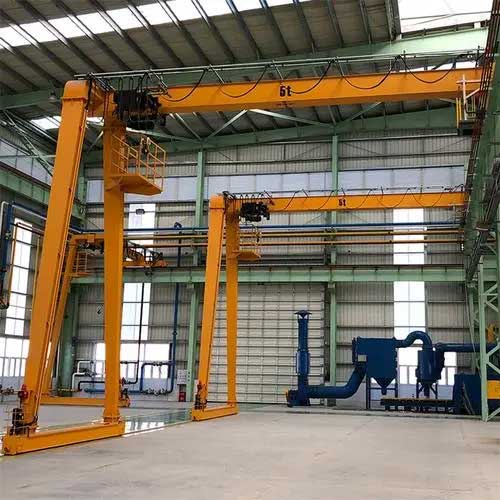Gantry Rail Crane for Sale All Types of Gantry Crane on Rails & Tracks
Gantry rail crane for sale.All types of gantry cranes on rails, ie., overhead bridge gantry rail cranes, with single & double girder, box & truss girder, with u frame & a frame gantries for containers & bulk material handling.
Category: Crane on Rail
Your Trusted Gantry Rail Crane Manufacturer & Supplier
Gantry Rail Crane for Sale, All Types of Gantry Crane on Rails & Tracks
Gantry rail crane for sale.All types of gantry cranes on rails, ie., overhead bridge gantry rail cranes, with single & double girder, box & truss girder, with u frame & a frame gantries for containers & bulk material handling.
Gantry rail crane for sale.All types of gantry cranes on rails, ie., overhead bridge gantry rail cranes, with single girder & double girder, box girder , truss girder, with u frame gantries, a frame gantries, and L frame gantries, for container and bulk material handling
Overview of Gantry Rail Cranes
Gantry Rail Cranes are heavy-duty lifting machines equipped with sturdy frameworks designed to run along railway tracks. Their primary function is to lift, move, and position heavy loads, offering exceptional utility in loading and unloading freight trains, managing cargo in ports, aiding in construction projects, and maintaining railway infrastructure.
Gantry rail cranes, often referred to as gantry cranes on rails, are specialized material handling machines designed to operate specifically on railway tracks or within rail yards. They are a type of gantry crane tailored for use in railway environments. These cranes are equipped with wheels or bogies that run along tracks, allowing them to move efficiently and precisely within designated areas of railway infrastructure.
Key features of gantry rail cranes include:
- Mobility on Tracks: Gantry rail cranes are mounted on tracks, enabling them to traverse along designated pathways within rail yards, terminals, or adjacent to railway lines.
- Cargo Handling: They are used for loading and unloading cargo, transferring shipping containers, handling bulk materials, or assisting in maintenance and construction tasks along railway tracks.
- Versatility: These cranes exhibit adaptability in various railway applications, supporting logistics operations, infrastructure maintenance, and construction projects.
- Precision and Efficiency: Gantry rail cranes offer precise movements and positioning, allowing efficient cargo handling and logistics optimization in railway environments.
These cranes play a crucial role in facilitating smooth and efficient operations within the railway industry, contributing to the movement and management of goods, maintenance of infrastructure, and overall logistical efficiency along railway tracks.
Gantry cranes form the backbone of railway logistics, streamlining operations crucial to the transportation of goods. They contribute significantly to the timely and efficient loading and unloading of freight, enabling the smooth flow of commodities and materials essential to industries, manufacturing, and global supply chains.
These cranes stand as essential tools in railway infrastructure, enhancing operational efficiency and serving as a linchpin in ensuring the continuous movement of goods along the tracks. In the subsequent sections, we'll delve deeper into the mechanisms, applications, and advancements of these remarkable machines, exploring their versatility and pivotal role in diverse industrial sectors.
Main Types of Gantry Rail Cranes
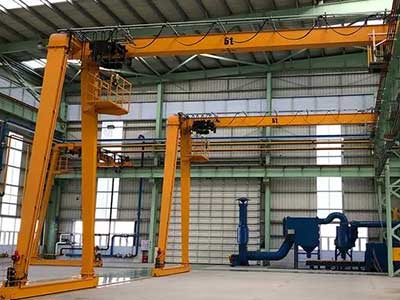
- Features: One end is supported by a structure while the other end travels along the railway track.
- Functions and Applications: Used in scenarios where there are structures or obstacles adjacent to the railway track, enabling effective loading and unloading without hindrance.
- Typical Loads Handled: Varied, based on the specific use case, not limited by its structure but optimized for handling in confined spaces.
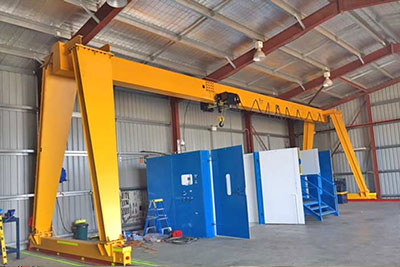
- Features: Complete bridge-like structure spanning multiple railway tracks, enabling movement along the tracks or within rail yards.
- Functions and Applications: Versatile loading and unloading operations across multiple tracks or within rail yards.
- Typical Loads Handled: Diverse range of cargo, from containers to heavy machinery, based on the crane's lifting capacity.
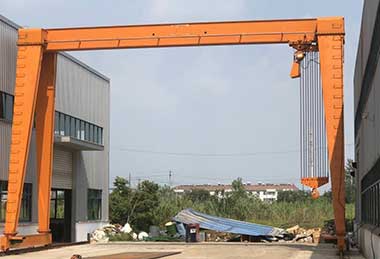
Single Girder Gantry Rail Cranes:
- Features: These cranes have a single girder (beam) supporting the hoist trolley.
- Functions and Applications: Suited for lighter lifting applications and situations where a simpler design is sufficient.
- Typical Loads Handled: Lighter loads in smaller rail yards, offering economical solutions for various industrial applications.
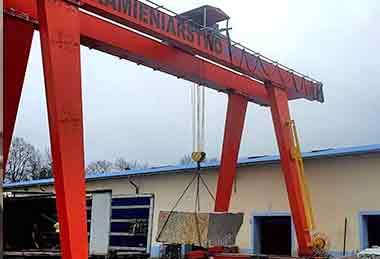
Double Girder Gantry Rail Cranes:
- Features: Equipped with two girders (beams) supporting the hoist trolley, providing higher stability and lifting capacities compared to single girder cranes.
- Functions and Applications: Designed for moderate to heavy lifting tasks that demand higher load capacities.
- Typical Loads Handled: Heavier loads in larger industrial settings or rail yards, handling bulk materials or heavy machinery.
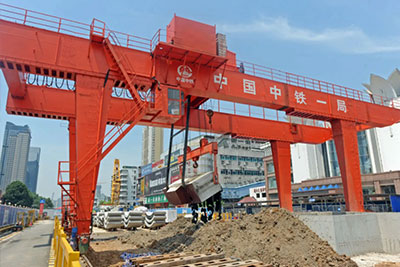
Box Girder Gantry Rail Cranes:
- Features: Have a box-shaped girder structure, providing additional strength and stiffness compared to traditional beam girders.
- Functions and Applications: Used in applications requiring higher precision and structural integrity.
- Typical Loads Handled: Varied loads, often preferred in situations where precision and rigidity are crucial, such as in certain manufacturing processes.
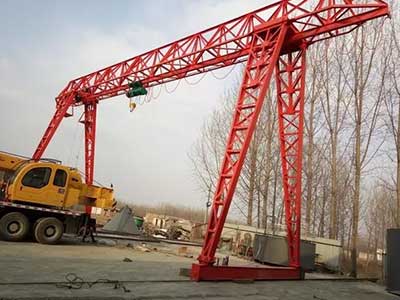
Truss Girder Gantry Rail Cranes:
- Features: Utilize a truss-style girder structure, consisting of interconnected triangles, offering strength and stability.
- Functions and Applications: Suitable for situations requiring high strength-to-weight ratio and flexibility in spans.
- Typical Loads Handled: Various loads, particularly advantageous in situations where lighter weight and spans are important factors.
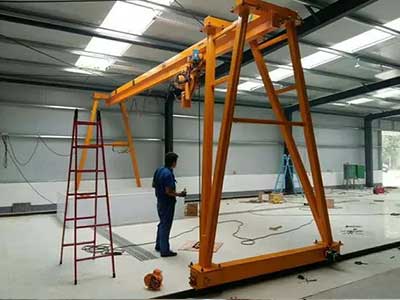
A-Frame Portable Gantry Rail Cranes:
- Features: Designed for portability and ease of assembly/disassembly, forming an A-frame structure.
- Functions and Applications: Used in scenarios requiring a mobile lifting solution, often in workshops, warehouses, or construction sites.
- Typical Loads Handled: Lighter loads, providing flexibility for temporary lifting needs in different locations.
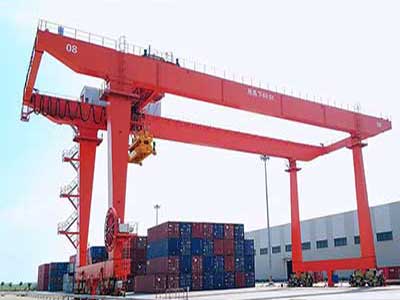
- Features: Structured in a U-frame design, offering stability and load-bearing capacity.
- Functions and Applications: Suitable for medium to heavy-duty lifting tasks in rail yards or industrial environments.
- Typical Loads Handled: Varied loads, commonly used in scenarios requiring stability and reliability.
Singl Girder Gantry Rail Cranes
The Single Girder Gantry Rail Crane stands as a testament to efficiency and simplicity in design. It features a single horizontal beam, the girder, which spans the width of the crane. This configuration offers a lightweight yet robust structure, allowing for swift movement and precise load handling. By employing a hoist and trolley system, this crane facilitates vertical and horizontal movement of goods with utmost ease.
Single girder gantry rail cranes are a type of gantry crane with a single horizontal beam, known as a girder, spanning the width of the crane. These cranes are designed for various lifting and material handling applications in industries where moderate lifting capacities are required. There are several types of single girder gantry rail cranes, each catering to specific needs and operational requirements. The main types include:
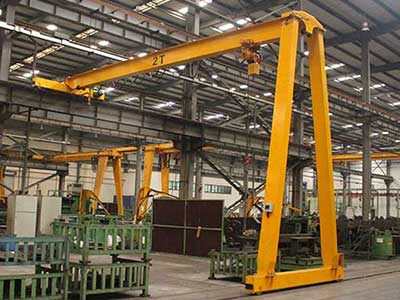
Wall-Mounted Single Girder Gantry Cranes: These cranes are mounted on walls or existing structures, providing an overhead lifting solution without the need for floor space. They are suitable for limited spaces where floor-mounted cranes are impractical.
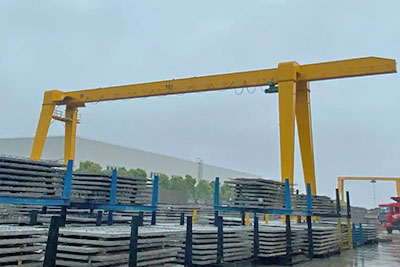
Cantilever Single Girder Gantry Cranes: This type features a single girder extending beyond the supporting legs, offering extended reach and providing easier access to materials in specific areas. Cantilever cranes are useful for accessing workstations or areas obstructed by obstacles.
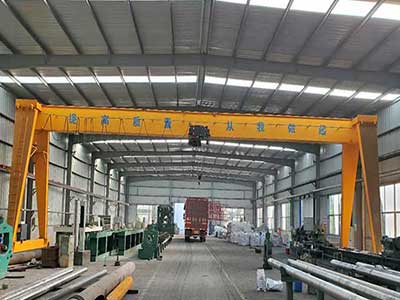
European-style Single Girder Gantry Cranes: These cranes follow European design standards and often feature compact designs, precise controls, and high-quality components. They are known for their reliability, efficiency, and advanced features.
Each type of single girder gantry rail crane has distinct features and advantages, catering to different industries and lifting requirements. The selection of the appropriate type depends on factors such as the nature of the materials being handled, available space, lifting capacity needed, and specific operational demands.
Single Girder Gantry Rail Cranes based on Girder Design:
- Box Girder Single Girder Gantry Rail Crane: - Utilizes a box-shaped girder for enhanced strength and resistance to torsion, providing increased load capacity and structural integrity. Commonly used in heavy-duty lifting operations where robustness is essential.
- Truss Girder Single Girder Gantry Rail Crane: - Incorporates a truss-style girder structure composed of interconnected triangular sections. This design offers a high strength-to-weight ratio, stability, and reduced weight, suitable for various industrial applications.
- Beam Girder Single Girder Gantry Rail Crane: - Features a traditional beam girder design, offering a simpler and cost-effective solution for moderate lifting requirements in industries such as workshops, warehouses, and manufacturing facilities.
Single Girder Gantry Rail Cranes based on Style or Origin:
- Wall-Mounted Single Girder Gantry Cranes: - Mounted on walls or existing structures, these cranes provide overhead lifting solutions without using floor space, suitable for limited-space environments where floor-mounted cranes may not be feasible.
- Floor-Mounted Single Girder Gantry Cranes: - Installed directly on the floor, offering stability and flexibility in handling various loads. These cranes are widely used in industries requiring efficient material handling within the available floor space.
- European-style Single Girder Gantry Cranes: - Follow European design standards, known for their high-quality components, precise controls, and reliability. They offer advanced features and are often utilized in industries where precision and efficiency are paramount.
- Chinese-style Single Girder Gantry Cranes: - Reflecting design practices from China, these cranes may offer specific characteristics tailored to regional industrial requirements, potentially focusing on cost-efficiency and functionality.
Each type of Single Girder Gantry Rail Crane has distinct features and advantages, catering to specific lifting needs, operational environments, and regional preferences. The selection of the most suitable type depends on factors such as load capacity, space availability, lifting requirements, and industry standards or preferences.
Features and Benefits
- Versatility: The Single Girder Gantry Rail Crane's adaptable design enables it to operate efficiently in various spaces, making it an ideal choice for facilities with limited headroom.
- Cost-effectiveness: With its streamlined construction, this crane type often proves to be a cost-effective solution for material handling needs without compromising on performance.
- Space Optimization: Its compact nature doesn't compromise on lifting capabilities, ensuring optimal use of available workspace while efficiently managing heavy loads.
Typical Applications in Industries (Manufacturing, Warehousing, etc.)
In the realm of manufacturing, the Single Girder Gantry Rail Crane finds itself as a cornerstone for efficient production. Its ability to handle moderate loads with precision makes it a preferred choice in assembly lines, workshops, and fabrication units. Additionally, warehouses and distribution centers benefit from its maneuverability and space utilization, making it a pivotal asset in logistics operations.
Double Girder Gantry Rail Crane
The Double Girder Gantry Rail Crane stands out prominently with its robust construction, characterized by the presence of two horizontal girders instead of one. This configuration significantly enhances its load-bearing capacity, allowing it to handle heavier weights compared to its single girder counterpart. The structural difference in the twin girders offers increased stability and support, enabling it to tackle more demanding lifting tasks.
Double girder gantry rail cranes, known for their robustness and high load-bearing capacity, come in various types designed to suit different industrial applications. Here are some common types:
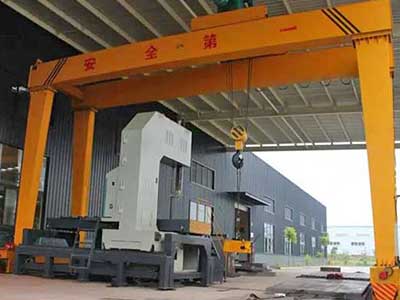
Full Gantry Double Girder Rail Cranes: - These cranes feature two horizontal girders supported by vertical legs on both ends. They are known for their high stability and are commonly used in heavy industries requiring precise and heavy-duty lifting.
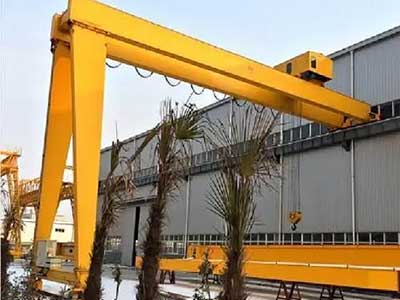
Semi-Gantry Double Girder Rail Cranes: - Similar to the semi-gantry single girder crane, these cranes feature one end of the crane supported by a runway beam or wall, while the other end moves along the rail. They are suitable for environments where a full gantry setup isn't necessary.
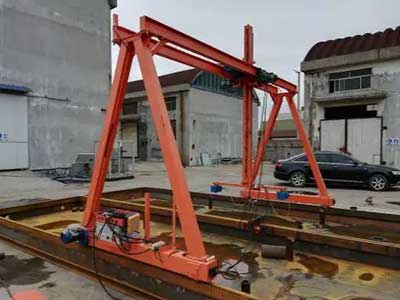
Portable Double Girder Rail Cranes: - Portable versions of double girder cranes are designed for ease of transportation and assembly. They offer mobility and are suitable for temporary or changing work environments.
Each type of double girder gantry rail crane serves specific industrial needs and operational requirements. The choice of crane type depends on factors such as the weight and nature of the materials to be lifted, the available space, required lifting height, and the specific needs of the industry or application.
Key Features and Advantages
- Heavy Lifting Capability: The dual girder design elevates the crane's lifting capacity, making it ideal for handling substantial loads with ease and precision.
- Enhanced Height and Span: With increased stability, the Double Girder Gantry Rail Crane can reach greater heights and span wider distances, catering to operations requiring extended coverage.
- Durability and Longevity: Its robust build ensures durability, making it a long-term investment for industries dealing with consistently heavy lifting demands.
Specific Applications and Industries Utilizing Double Girder Cranes
Industries requiring the handling of bulky and weighty materials rely on the Double Girder Gantry Rail Crane for its remarkable lifting prowess. Sectors such as steel production, shipyards, and heavy machinery manufacturing benefit immensely from this crane type's ability to effortlessly manage oversized components and machinery.
The Double Girder Gantry Rail Crane emerges as the backbone of operations demanding formidable lifting capabilities. Its structural strength and versatility position it as a preferred choice across industries requiring a reliable solution for handling substantial loads.
Semi-Gantry Rail Crane
The Semi-Gantry Rail Crane presents a unique configuration, featuring a single supporting leg and a gantry beam that travels along the rail on one end, while the other end moves on the ground or another lower runway beam. This design combines the advantages of a traditional gantry crane with the flexibility of an overhead crane. It offers a cost-effective alternative where the full span of a gantry crane isn't necessary.
Semi-gantry rail cranes are versatile lifting solutions commonly used in various industrial settings. They come in both indoor and outdoor variations, each tailored to suit specific operational requirements and environmental conditions:
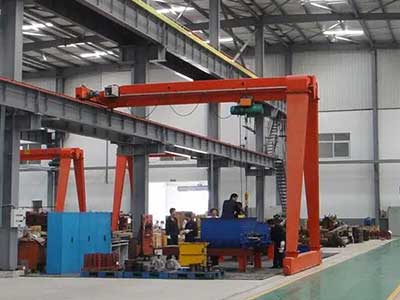
Indoor Semi-Gantry Rail Cranes:
Features:
- Designed for use within indoor industrial facilities such as workshops, warehouses, manufacturing plants, and assembly lines.
- One end of the crane is supported by a wall or a runway beam, while the other end moves along a rail mounted on the floor.
- Utilizes the available indoor space efficiently without obstructing the entire workspace.
Advantages:
- Optimize space: Ideal for indoor areas where a full gantry crane setup might be impractical due to space limitations.
- Flexibility: Offers flexibility in material handling within confined indoor spaces.
- Precision: Enables precise lifting and movement of loads within the designated indoor area.
Applications:
- Commonly used in manufacturing units for handling machinery parts, assembling products, moving materials within warehouses, and other indoor material handling tasks.
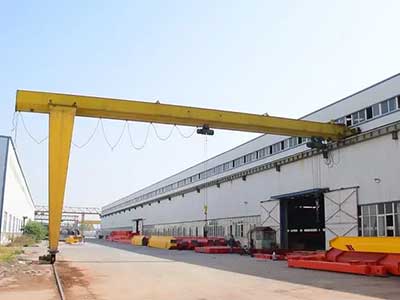
Outdoor Semi-Gantry Rail Cranes:
Features:
- Designed to operate in outdoor environments, such as construction sites, open yards, loading docks, and outdoor manufacturing facilities.
- One side of the crane is supported by a fixed structure (e.g., a concrete column or wall), while the other side moves on the rail system outdoors.
Advantages:
- Versatility: Suited for outdoor applications requiring flexible material handling and lifting capabilities.
- Heavy-duty operations: Capable of handling heavier loads outdoors compared to indoor versions.
- Weather resistance: Designed with materials that withstand exposure to outdoor elements such as sunlight, rain, and temperature variations.
Applications:
- Widely used in outdoor construction sites for lifting and moving construction materials, loading and unloading operations in ports, and handling materials in outdoor logistics and storage yards.
Both indoor and outdoor semi-gantry rail cranes offer efficient material handling solutions, but their design and construction cater to the distinct needs of different operational environments. The choice between indoor and outdoor variants depends on factors such as space availability, load requirements, environmental conditions, and the specific tasks to be performed.
Unique Features and Advantages of Semi Gantry Rail Cranes
- Space Optimization: The Semi-Gantry Rail Crane's design allows for efficient use of space by utilizing the support of one leg, making it suitable for areas with restricted floor space or irregular layouts.
- Flexibility in Design: Its adaptable nature enables customization based on specific operational requirements, offering a tailored solution for diverse lifting needs.
- Cost-Efficiency: As it requires fewer supporting structures than a full gantry crane, the Semi-Gantry Crane presents a more economical option without compromising functionality.
Typical Industrial Applications and Benefits
Industries seeking a balance between functionality and cost-effectiveness find the Semi-Gantry Rail Crane to be an optimal choice. Its ability to handle moderate to heavy loads in confined spaces makes it invaluable in environments such as manufacturing workshops, maintenance facilities, and construction sites where space constraints pose a challenge.
The Semi-Gantry Rail Crane emerges as a practical solution for operations demanding versatility and adaptability. Its ability to bridge the gap between traditional gantry cranes and overhead cranes proves instrumental in various industries, offering a tailored lifting solution while optimizing both space and resources.
Light Duty Portable Gantry Rail Cranes
Light Duty Portable Gantry Rail Cranes are engineered with a focus on maneuverability and ease of assembly. These cranes boast a lightweight yet robust construction, featuring a portable design that allows for quick setup and relocation. They usually come in modular parts, facilitating easy transportation and assembly without the need for specialized tools or equipment.

light duty gantry crane on rails
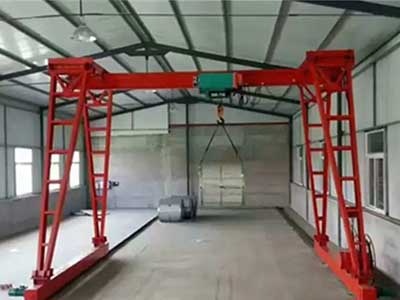
Portable gantry rail cranes

Light duty portable gantry crane on rails
Unique Features and Advantages
- Portability and Mobility: Their lightweight structure and modular design make them easily transportable and suitable for temporary or changing work environments.
- Quick Assembly: These cranes are designed for rapid setup and breakdown, enabling efficient use in different locations or tasks within a short timeframe.
- Adaptability: They offer adaptability to various industries due to their ability to handle lighter loads while maintaining operational efficiency.
Typical Industrial Applications and Benefits
Light Duty Portable Gantry Rail Cranes find their niche in industries requiring versatile and temporary lifting solutions. Sectors such as maintenance workshops, event setups, small-scale manufacturing, and construction sites benefit from their easy-to-move nature and capability to handle lighter loads efficiently.
The adaptability and ease of use of Light Duty Portable Gantry Rail Cranes make them a practical choice for short-term projects, temporary lifting needs, or scenarios where frequent relocation is necessary. Their portability and functionality strike a balance between mobility and lifting capability, catering to a spectrum of industries with specific requirements.
Comparisons of Types fo Gantry Rail Cranes
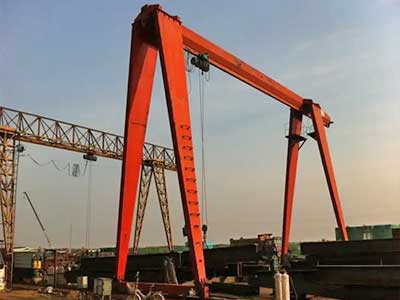
Single Girder Gantry Rail Cranes:
Features:
- Single girder supporting the hoist trolley.
- Typically lighter in weight due to a simpler design.
- Suited for lighter lifting applications.
Functions and Applications:
- Economical choice for smaller rail yards.
- Suitable for handling lighter loads.
- Used in various industrial applications.
Typical Loads Handled:
- Lighter loads within smaller industrial settings.
- Offers cost-effective solutions for moderate lifting tasks.
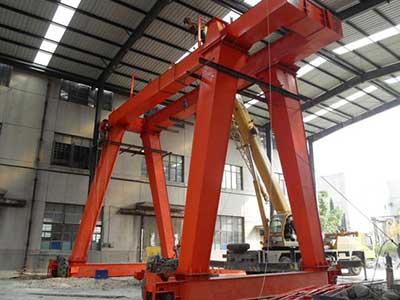
Double Girder Gantry Rail Cranes:
Features:
- Two girders (beams) supporting the hoist trolley.
- Offers higher stability and lifting capacities.
- Heavier in weight due to the dual girder structure.
Functions and Applications:
- Designed for moderate to heavy lifting tasks.
- Ideal for larger industrial settings or rail yards.
- Provides greater lifting capacity compared to single girder cranes.
Typical Loads Handled:
- Heavier loads within larger industrial environments.
- Suitable for handling bulk materials or heavy machinery.
Comparison Table:
| Features | Single Girder Gantry Crane | Double Girder Gantry Crane |
|---|---|---|
| Girder Configuration | Single girder | Two girders |
| Weight | Lighter due to simpler design | Heavier due to dual girder structure |
| Stability | Moderate stability | Higher stability |
| Lifting Capacity | Suitable for lighter loads | Higher capacity for heavier loads |
| Applications | Smaller industrial settings | Larger industrial settings or rail yards |
| Cost-effectiveness | Economical choice | Higher initial cost, greater lifting capacity |
This table summarizes the key differences and similarities between single girder and double girder gantry rail cranes, focusing on girder configuration, weight, stability, lifting capacity, applications, and cost-effectiveness.

Box Girder Gantry Rail Cranes:
Features:
- Girder structure shaped like a box for added strength and stiffness.
- Offers higher resistance to bending and torsional forces.
- Often used where precision and structural integrity are crucial.
Functions and Applications:
- Ideal for applications requiring higher structural rigidity.
- Suitable for lifting operations demanding precision.
Typical Loads Handled:
- Diverse loads, often where precision and rigidity are essential factors.
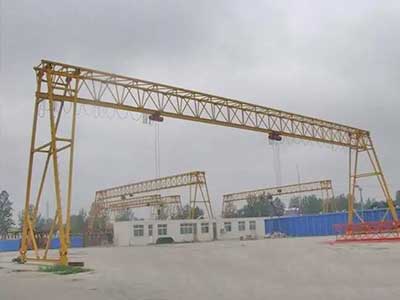
Truss Girder Gantry Rail Cranes:
Features:
- Utilizes a truss-style girder structure composed of interconnected triangles.
- Offers a high strength-to-weight ratio and flexibility in spans.
- Provides stability with reduced material usage.
Functions and Applications:
- Ideal for applications requiring high strength-to-weight ratio.
- Suitable for situations with lighter weight and spans.
Typical Loads Handled:
- Various loads, advantageous where lighter weight and spans are essential.
Comparison Table:
| Features | Box Girder Gantry Crane | Truss Girder Gantry Crane |
|---|---|---|
| Girder Structure | Shaped like a box for added strength and stiffness | Composed of interconnected triangles |
| Strength and Rigidity | High resistance to bending and torsional forces | High strength-to-weight ratio, flexibility in spans |
| Functionality | Suitable for applications requiring precision and structural integrity | Ideal for scenarios demanding high strength-to-weight ratio and flexibility |
| Typical Applications | Tasks requiring precision and structural rigidity | Situations requiring lighter weight and spans |
| Load Handling | Diverse loads requiring precision and rigidity | Varied loads with a focus on lighter weight and spans |
This table provides a concise summary of the key differences and similarities between box girder and truss girder gantry rail cranes, focusing on girder structure, strength, functionality, typical applications, and load handling capabilities.
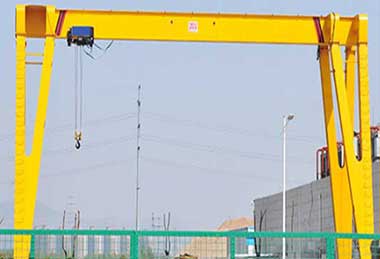
A-Frame Portable Gantry Rail Cranes:
Features:
- Structured in an A-frame design for portability and ease of assembly/disassembly.
- Designed to be movable for various lifting needs in different locations.
- Often used in workshops, warehouses, or construction sites.
Functions and Applications:
- Ideal for scenarios requiring a mobile lifting solution.
- Provides flexibility for temporary lifting needs in different locations.
Typical Loads Handled:
- Lighter loads due to their portable nature.
- Used for diverse lifting applications in temporary settings.
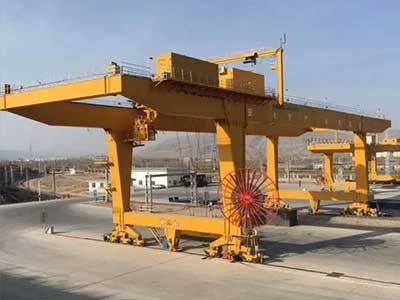
U-Frame Rail Gantry Cranes:
Features:
- Structured in a U-frame design, providing stability and load-bearing capacity.
- Suitable for medium to heavy-duty lifting tasks.
- Used in rail yards or industrial environments.
Functions and Applications:
- Offers stability and reliability for lifting applications.
- Ideal for medium to heavy-duty lifting operations.
Typical Loads Handled:
Varied loads, commonly used in scenarios requiring stability and load-bearing capacity.
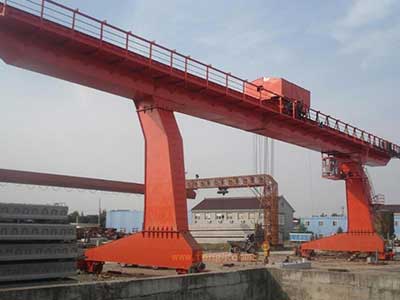
L-Leg Gantry Rail Cranes:
Features:
- Characterized by an L-shaped leg structure, offering support and stability.
- Used for various lifting applications in industrial settings.
- Provides stability and flexibility in lifting operations.
Functions and Applications:
- Offers stability and support for lifting heavy loads.
- Suitable for different industrial lifting requirements.
Each type of gantry rail crane has its unique design features and functionalities, catering to different lifting capacities, structural requirements, and applications within railway environments and industrial settings.
Typical Loads Handled:
Diverse range of loads, providing stability and flexibility in lifting operations.
Comparison Table:
| Features | A-Frame Portable Gantry Crane | U-Frame Rail Gantry Crane | L-Leg Gantry Rail Crane |
|---|---|---|---|
| Frame Structure | A-frame design for portability | U-frame structure | L-shaped leg structure |
| Portability | Designed for mobility | Stationary design | Stationary design |
| Stability | Portable but less stable | Stable with load-bearing capacity | Stability with support structure |
| Applications | Mobile lifting solution | Rail yards or industrial settings | Industrial lifting operations |
| Load Handling | Lighter loads in temporary settings | Varied loads with stability | Diverse loads with stability and flexibility |
This table outlines the key differences and similarities between A-frame portable, U-frame rail, and L-leg gantry rail cranes, focusing on frame structure, portability, stability, applications, and load handling capabilities.
Gantry Rail Cranes Types on Crane Applications and Uses
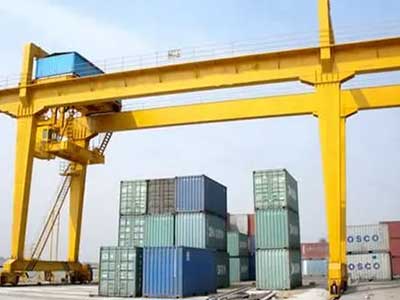
- Features: Specially designed for handling shipping containers. They operate on tracks within ports or intermodal terminals.
- Functions and Applications: Efficiently load and unload containers from trains, trucks, and ships.
- Typical Loads Handled: Shipping containers of various sizes and weights.
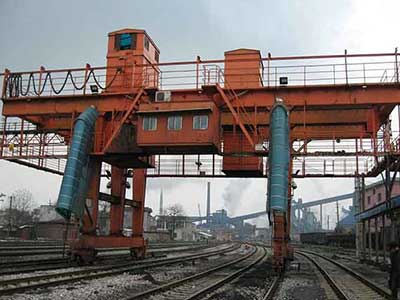
- Features: Equipped with specialized tools for maintenance and repair work on railway tracks, bridges, or overhead lines.
- Functions and Applications: Used for infrastructure maintenance and repair tasks along railway lines.
- Typical Loads Handled: Machinery, tools, and materials used for railway maintenance.
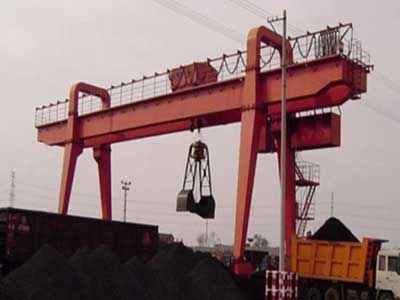
Bulk Handling Grab Bucket Gantry Crane:
- Features: Tailored for handling loose bulk materials like coal, ores, and grains, often equipped with specialized attachments.
- Functions and Applications: Handling bulk materials commonly transported by rail within rail yards or industrial areas.
- Typical Loads Handled: Coal, ores, grains, and other loose bulk materials.
Different Configurations: Gantry Crane on Rails vs. Other Crane Types
Gantry cranes on rails stand distinct from other crane types due to their unique configuration designed explicitly for railway operations. While traditional gantry cranes may have fixed positions or run on gantry systems, those mounted on railway tracks offer mobility and adaptability along designated paths, optimizing cargo handling within railway environments.
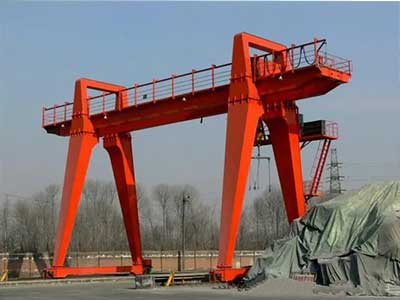
Gantry Rail Cranes:
Features:
- Mounted on railway tracks, enabling movement along designated paths within rail yards or industrial areas.
- Suitable for lifting and handling operations along railway tracks.
Functions and Applications:
- Designed for efficient cargo handling, maintenance, and logistical operations along railway tracks.
- Typically used in railway depots, ports, or industrial environments with railway access.
Typical Loads Handled:
- Diverse loads including containers, bulk materials, machinery, and maintenance equipment along railway lines.
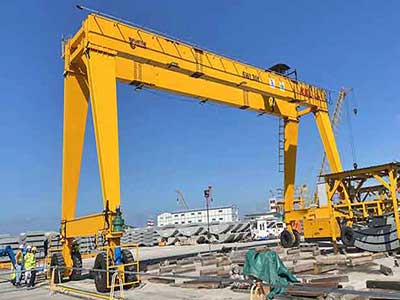
Rubber-Tired Wheel Gantry Cranes:
Features:
- Equipped with rubber tires for mobility on paved surfaces or industrial floors.
- Offers flexibility to operate in various locations without dedicated tracks.
Functions and Applications:
- Used in areas where track infrastructure is not available or where mobility across different surfaces is necessary.
- Suitable for ports, construction sites, or warehouses with variable terrain.
Typical Loads Handled:
- Similar to rail gantry cranes, these handle various loads but offer more flexibility in terms of mobility.
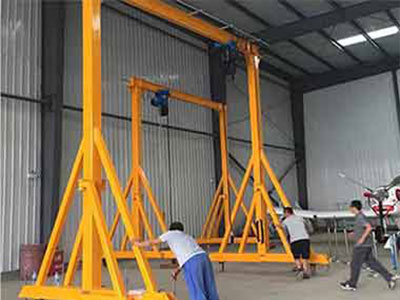
Roller Traveling Gantry Cranes:
Features:
- Utilizes rollers or wheels along a fixed track or runway within an industrial facility.
- Provides a fixed path for movement within the facility.
Functions and Applications:
- Used in manufacturing plants, warehouses, or industrial sites where a fixed track or runway is installed.
- Offers precise movement along a fixed path within the facility.
Typical Loads Handled:
- Varied loads depending on the industrial application within the facility.
Comparative Table:
| Features | Gantry Rail Cranes | Rubber-Tired Wheel Gantry Cranes | Roller Traveling Gantry Cranes |
|---|---|---|---|
| Mobility | Operate on railway tracks | Operate on rubber tires | Movement on fixed tracks or runway |
| Usage | Railway depots, ports, industrial areas | Ports, construction sites, warehouses | Manufacturing plants, warehouses |
| Track Infrastructure | Requires railway tracks | No dedicated tracks required | Fixed track or runway within facility |
| Mobility Range | Restricted to tracks | Flexible mobility across surfaces | Fixed path within facility |
| Typical Loads Handled | Diverse loads along railway tracks | Various loads, adaptable mobility | Varied loads within the facility |
This comparative analysis highlights the distinctions and similarities between gantry rail cranes, rubber-tired wheel gantry cranes, and roller traveling gantry cranes concerning their mobility, usage, track infrastructure, typical applications, and loads handled.
Specifics of Gantry Cranes Mounted on Railway Tracks
Gantry cranes mounted on railway tracks boast specialized features conducive to railway logistics. These cranes are engineered with wheels or bogies that traverse the tracks, allowing seamless movement along the rail lines. Their design emphasizes stability, precision, and load-bearing capacity, facilitating efficient loading and unloading operations in rail yards, terminals, and construction sites adjacent to railway tracks.
Applications and Advantages of Gantry Cranes on Tracks
The applications of gantry cranes on tracks span various sectors within the railway industry. They excel in:
- Loading and unloading cargo from freight trains, ensuring swift and accurate transfers.
- Handling shipping containers in ports and intermodal terminals, streamlining container operations between trains and ships.
- Aiding in maintenance and construction projects along railway lines, facilitating efficient infrastructure work.
The advantages of gantry cranes on tracks include enhanced maneuverability, optimized cargo handling, and the ability to cover extensive lengths of railway tracks. Their mobility allows for precise positioning, enabling efficient operations even in constrained railway spaces.
Gantry Crane Track Systems
Rail tracks form the fundamental infrastructure supporting the operations of Gantry Rail Cranes. Understanding the intricacies of gantry crane track systems is essential to grasp the efficiency and functionality of these cranes within railway logistics.
Gantry crane rail tracks serve as designated pathways upon which these cranes operate. These tracks are meticulously designed to provide stability and a guided path for the crane's movement. Typically, they consist of sturdy steel rails laid in parallel alignment, ensuring smooth and precise traversal for the gantry cranes.
Design and Structure of Gantry Crane Track Systems
The design and structure of gantry crane track systems are tailored to withstand heavy loads and offer optimal support for the cranes' movements. The tracks often feature specialized components such as sleepers or ties, ensuring the proper distribution of weight and minimizing track stress under load.
Moreover, these tracks are engineered to provide consistent alignment, allowing the gantry cranes to traverse smoothly along their designated pathways. Robust anchoring systems secure the tracks firmly to the ground, maintaining stability and structural integrity during crane operations.
Functionality and Significance of Rails for Gantry Cranes
Rails within gantry crane track systems play a critical role in facilitating the movement and operation of the cranes. They serve as the guiding mechanism for the crane's wheels or bogies, ensuring precise alignment and controlled movement. This functionality is pivotal in enabling gantry cranes to efficiently position themselves for loading, unloading, or transferring cargo along the railway tracks.
The significance of well-maintained rails cannot be overstated, as they directly impact the performance and safety of gantry cranes. Properly aligned and maintained tracks ensure smooth operations, reducing wear and tear on the crane components and maximizing their efficiency.
Understanding the design intricacies and functionality of gantry crane track systems lays the groundwork for comprehending the operational efficiency and adaptability of these cranes along railway tracks.
Operational Efficiency of Gantry Cranes on Rails
Gantry cranes operating on railway tracks are pivotal in ensuring the operational efficiency and streamlined logistics within the railway industry.
- Efficiency in Cargo Handling for Railway Logistics -The utilization of gantry cranes on rails significantly enhances the efficiency of cargo handling operations in railway logistics. These cranes are adept at swiftly and precisely loading and unloading freight trains, contributing to the seamless flow of goods across railway yards and terminals. Their capability to handle various cargo types, from containers to bulk materials, streamlines logistics, expediting the transfer of goods to their intended destinations.
- Enhanced Movements and Positioning Along Tracks -One of the standout features of gantry cranes on rails lies in their ability to traverse along designated tracks. This mobility grants these cranes unparalleled agility and precision in movements. They can effortlessly position themselves at desired locations, optimizing cargo handling and eliminating the need for manual repositioning, thereby saving time and increasing productivity in railway operations.
- Importance of Adaptability and Versatility in Gantry Rail Cranes -Adaptability and versatility are inherent strengths of gantry rail cranes. Their capacity to navigate various terrains and traverse through curved or straight tracks makes them invaluable assets in railway environments. These cranes can adjust to different cargo sizes and weights, catering to the diverse needs of cargo handling operations within the railway industry.
The operational efficiency of gantry cranes on rails not only expedites cargo handling processes but also contributes to the overall productivity and fluidity of railway logistics.
Gantry Rail Cranes in Industrial Operations
Gantry Rail Cranes play an integral role across a spectrum of industries, serving as an instrumental tool in streamlining operations, optimizing productivity, and ensuring safety. From heavy manufacturing plants requiring robust lifting capacities to warehouses demanding agile material handling solutions, these cranes offer a versatile solution adaptable to diverse industrial needs.
In the forthcoming sections, we'll delve deeper into the different types of Gantry Rail Cranes, their unique features, benefits, and how these cranes find applications across various industries. Join us as we explore the immense potential and functionalities of these stalwart machines that continue to redefine efficiency and reliability in the realm of material handling.
Features, Benefits, and Applications of Gantry Rail Cranes
Gantry Rail Cranes encompass a range of features that distinguish them as indispensable assets in material handling. These features are integral to ensuring efficiency, safety, and adaptability across various industries.
Precision Control Systems
- Advanced Control Mechanisms: Gantry Rail Cranes are equipped with cutting-edge control systems, allowing operators precise and smooth handling of loads. This includes technologies like variable frequency drives (VFDs) that enable speed adjustments and precise positioning.
- Automated Controls: Some models incorporate automation features, such as PLC-based systems, enabling programmed movements and load monitoring for enhanced operational efficiency.
Load Capacity and Versatility
- Varied Load Capacities: Gantry Rail Cranes come in diverse load capacities, ranging from light-duty to heavy-duty, catering to a wide spectrum of lifting requirements within industries.
- Versatility in Applications: The ability to handle various load types, shapes, and sizes makes Gantry Rail Cranes adaptable to different tasks, from moving machinery parts to handling raw materials and finished products.
Safety Features (Rail Alignment, Emergency Stop, etc.)
- Rail Alignment Systems: These cranes often feature precise rail alignment mechanisms to ensure smooth and accurate movements along the designated track, reducing the risk of accidents or misalignment.
- Emergency Stop and Safety Measures: Gantry Rail Cranes prioritize safety with emergency stop functionalities and safety features like overload protection, limit switches, and interlocks, ensuring a secure working environment.
The incorporation of precision control systems, versatile load capacities, and stringent safety features solidifies Gantry Rail Cranes as not just lifting solutions but reliable partners in enhancing productivity while prioritizing safety in industrial operations.
Benefits of Using Gantry Rail Cranes
The utilization of Gantry Rail Cranes offers a multitude of advantages that significantly impact operational efficiency, customization, and long-term cost-effectiveness across diverse industrial settings.
Increased Efficiency in Material Handling
- Streamlined Operations: Gantry Rail Cranes optimize material handling processes, allowing for swift and precise movements of heavy loads, reducing downtime, and enhancing overall workflow efficiency.
- Time and Labor Savings: Their ability to efficiently move materials across a designated area reduces manual handling requirements, saving time and minimizing the need for additional labor.
Flexible and Customizable Designs
- Tailored Solutions: Gantry Rail Cranes offer flexibility in design, enabling customization to suit specific operational requirements, whether it involves adjusting lifting capacities, spans, or incorporating specialized attachments.
- Adaptability to Various Environments: Their customizable nature allows seamless integration into diverse industrial environments, enhancing productivity while accommodating specific spatial constraints or operational demands.
Cost-Effectiveness and Long-Term Reliability
- Operational Cost Savings: With their efficiency in material handling and streamlined processes, Gantry Rail Cranes contribute to reducing operational costs and maximizing resource utilization.
- Long-Term Reliability: Engineered for durability and longevity, these cranes offer a reliable, long-term solution, minimizing downtime due to maintenance issues and ensuring consistent performance over extended periods.
The utilization of Gantry Rail Cranes yields multifaceted benefits, ranging from heightened operational efficiency and adaptability to long-term reliability and cost-effectiveness. These advantages make them an indispensable asset across industries, driving productivity while maintaining a competitive edge.
Typical Applications Across Industries
Construction and Infrastructure Development:
- Bridge Construction Gantry Rail Cranes: Specifically designed for the assembly and installation of bridge sections, assisting in lifting heavy components for bridge construction projects.
- Building Construction Gantry Rail Cranes: Used for lifting materials like steel beams, concrete panels, and other construction components in the building process, aiding in the vertical construction of buildings.
Manufacturing and Heavy Industrial Applications:
- Steel Industry Gantry Rail Cranes: Specialized for handling molten metal, moving heavy coils, and transporting finished steel products within steel manufacturing plants.
- Automotive Manufacturing Gantry Rail Cranes: Utilized in automobile assembly lines for precise handling of car bodies, engines, and other heavy parts during manufacturing processes.
Ports, Shipyards, and Logistics:
- Port Container Handling Gantry Rail Cranes: Specifically designed for efficiently loading and unloading cargo containers in ports and container terminals.
- Shipbuilding Yard Gantry Rail Cranes: Aids in assembling and maintaining ships by lifting and positioning heavy ship components and sections during construction.
Warehousing and Logistics Operations:
- Warehouse Material Handling Gantry Rail Cranes: Used for loading/unloading goods, moving heavy pallets, and optimizing storage space within warehouses and distribution centers.
Specialized Industrial Operations:
- Foundry and Heavy Metal Industry Gantry Rail Cranes: Designed for handling heavy metal components, molds, and castings in foundries and heavy metal industries.
- Nuclear Industry Gantry Rail Cranes: Specially engineered for handling radioactive materials and heavy machinery within nuclear power plants.
Maintenance and Small-Scale Operations:
- Maintenance Workshop Gantry Rail Cranes: Suitable for smaller-scale operations, maintenance workshops, and repair facilities, assisting in lifting machinery and parts during maintenance tasks.
Industrial Applications and Use Cases
A. Specific Industrial Scenarios Utilizing Gantry Rail Cranes
Shipbuilding Yards and Ports
- Ship Assembly and Maintenance: Shipbuilding yards rely on Gantry Rail Cranes for the efficient assembly of vessels, lifting heavy ship components, and facilitating maintenance tasks. These cranes assist in positioning massive sections of ships and moving them across the yard for welding and fitting.
- Port Operations: Gantry Rail Cranes in ports manage cargo containers, efficiently loading and unloading ships, ensuring swift logistics operations, and optimizing port productivity.
Automotive Manufacturing Plants
- Assembly Line Operations: Gantry Rail Cranes play a pivotal role in automotive manufacturing plants by precisely maneuvering vehicle bodies, engines, and large components along assembly lines. They aid in the efficient installation of heavy parts and ensure smooth workflow processes.
- Material Handling and Storage: These cranes facilitate the movement of raw materials and storage of components in designated areas, ensuring streamlined inventory management and efficient production processes.
Steel Mills and Foundries
- Raw Material Handling: Gantry Rail Cranes are fundamental in steel mills for transporting raw materials like scrap metal, molten metal, and slabs, contributing to the continuous flow of production.
- Precise Placement of Heavy Loads: In foundries, these cranes assist in the precise positioning of molds, heavy castings, and furnace components, ensuring accurate processes in metal shaping and casting.
Gantry Rail Cranes stand as indispensable assets in various industrial settings, facilitating critical operations, optimizing workflow efficiency, and ensuring safety while handling heavy loads. Their adaptability and robust functionality make them integral to the success of industries involved in shipbuilding, automotive manufacturing, steel production, and more.
User Concerns and Common Questions
Safety Considerations in Gantry Rail Crane Operation
- Operator Training: Ensuring operators receive comprehensive training in crane operation, safety protocols, and emergency procedures is paramount to minimize risks.
- Regular Inspections: Conducting routine inspections of crane components, rails, and safety systems helps identify and address potential hazards or malfunctions promptly.
- Safety Features Utilization: Emphasizing the use of safety features such as limit switches, emergency stops, and overload protection ensures a safer working environment during crane operation.
Maintenance Requirements and Service Life
- Scheduled Maintenance: Adhering to a regular maintenance schedule, including lubrication, component checks, and structural inspections, is vital for prolonging the crane's service life.
- Professional Service and Repairs: Engaging qualified technicians for repairs and maintenance tasks ensures adherence to manufacturer specifications, thus ensuring the crane's optimal performance.
- Monitoring Wear and Tear: Regularly monitoring wear and tear of critical components and promptly replacing or repairing them minimizes unexpected downtime and prolongs the crane's service life.
Customization Options and Adaptability
- Tailored Solutions: Exploring customization options, such as adjustable lifting capacities, different spans, or specialized attachments, allows the crane to be tailored to specific operational needs.
- Future Adaptability: Choosing cranes that offer scalability and future adaptations ensures they can accommodate potential changes in operational requirements or workspace configurations.
- Manufacturer Consultation: Consulting with crane manufacturers regarding customization possibilities and adaptations helps in selecting the most suitable crane for unique operational needs.
Addressing safety concerns, understanding maintenance requirements, and exploring customization options are vital aspects to consider when operating Gantry Rail Cranes. Prioritizing safety protocols, adhering to maintenance schedules, and exploring customization possibilities contribute significantly to maximizing the efficiency and safety of these powerful lifting solutions.
Frequently Asked Questions (FAQs) on Gantry Rail Cranes
How to Determine the Right Gantry Rail Crane for Specific Operations?
- Assess Lifting Requirements: Understanding the weight and dimensions of the loads to be handled is crucial in selecting the appropriate crane with the required lifting capacity.
- Consider Space and Environment: Evaluating the available space, ceiling height, and environmental conditions where the crane will operate aids in choosing the right crane type and size.
- Review Application Requirements: Identifying specific tasks, operational frequency, and any unique requirements (such as precision handling or specialized attachments) helps narrow down the ideal crane model.
What Safety Measures Are Incorporated in Gantry Rail Crane Designs?
Overload Protection: Gantry Rail Cranes often incorporate overload protection systems to prevent exceeding their specified lifting capacities, ensuring safe operations.
- Emergency Stop Features: These cranes are equipped with emergency stop functions to halt operations immediately in case of hazards or emergencies.
- Limit Switches and Rail Alignment Systems: Integrated limit switches and rail alignment mechanisms help prevent collisions, ensure proper alignment, and enhance overall safety during crane movements.
What Maintenance Practices Ensure Longevity and Optimal Performance?
- Regular Inspections: Scheduled inspections of critical components, including hoists, trolleys, and rail systems, ensure early detection of wear or damage.
- Lubrication and Cleaning: Regular lubrication of moving parts and cleaning of components prevent corrosion and ensure smooth crane operation.
- Professional Servicing: Engaging qualified technicians for periodic servicing and adhering to manufacturer-recommended maintenance procedures prolongs the crane's service life and maintains optimal performance.
Gantry Rail Cranes stand tall as indispensable assets in the realm of material handling, offering a multitude of advantages and finding diverse applications across industries. From their precision control systems and versatility to their contributions in streamlining operations across construction, manufacturing, and logistics, these cranes continue to redefine efficiency and reliability in industrial settings.
Explore the possibilities and potentials that Gantry Rail Cranes bring to your operations. For customized lifting solutions tailored to your specific industrial needs, we encourage further exploration, inquiries, and collaborations. Discover how these cranes can optimize your workflow, enhance safety, and contribute to the seamless execution of your projects.
Evolution and Innovations in Gantry Rail Cranes
The evolution of gantry rail cranes continues to be shaped by technological advancements, leading to enhanced functionalities and performance in railway applications.
Advancements in Gantry Crane Technology for Railway Applications
Technological advancements have spurred significant progress in gantry crane technology for railway applications. These cranes are evolving to offer improved load-bearing capacities, increased operational efficiency, and enhanced safety features. Manufacturers continually innovate to develop more robust and reliable gantry rail cranes capable of handling diverse cargo with precision and efficiency.
Future Trends: Automation, IoT, and AI Integration
The future of gantry rail cranes is poised for integration with cutting-edge technologies such as automation, Internet of Things (IoT), and Artificial Intelligence (AI). Automation in gantry crane operations can streamline processes, allowing for autonomous movements, precise positioning, and optimized cargo handling. Integration with IoT enables real-time data collection and analysis, facilitating predictive maintenance and operational optimizations. AI integration can further enhance decision-making processes, improving overall efficiency and safety in railway logistics.
These advancements and future trends in gantry rail crane technology signify a paradigm shift toward more efficient, intelligent, and adaptable machinery, setting the stage for transformative changes in the railway industry.
Safety Measures and Compliance for Gantry Cranes on Tracks
Safety is paramount in the operation of gantry cranes on railway tracks, and stringent measures are in place to ensure compliance with industry standards and regulations.
Safety Protocols in Gantry Crane Rail Track Operations
Gantry crane rail track operations necessitate rigorous safety protocols to mitigate risks and ensure secure operations. Regular inspections of the rail tracks, crane components, and safety devices are conducted to identify and address potential hazards promptly. Comprehensive training programs for operators focus on safe operating procedures, emergency response protocols, and hazard awareness to uphold a safe working environment.
Compliance with Industry Standards and Regulations
The operation of gantry cranes on railway tracks adheres to a myriad of industry standards and regulations. Compliance with standards set by organizations such as the Occupational Safety and Health Administration (OSHA), International Organization for Standardization (ISO), and various national railway safety authorities is imperative. These standards encompass design specifications, load capacities, structural integrity, and safety features, ensuring that gantry cranes meet or exceed safety benchmarks.
The commitment to adhering to strict safety measures and complying with industry regulations underscores the priority placed on safety in the operation of gantry cranes on railway tracks.
Purchasing Considerations and Maintenance Tips for Gantry Rail Cranes
Investing in gantry rail cranes requires thoughtful consideration of various factors, coupled with diligent maintenance practices to ensure their optimal performance and longevity.
Factors to Consider when Investing in Gantry Rail Cranes
When contemplating the purchase of gantry rail cranes, several crucial factors demand consideration. These include:
- Load Capacity and Specifications: Assessing the required load capacities and specifications pertinent to the intended applications.
- Track System Compatibility: Ensuring compatibility with existing or planned railway track systems.
- Safety Features: Verifying the presence and functionality of safety features to meet industry standards.
- Manufacturer Reputation: Evaluating the reputation and track record of manufacturers for reliability and quality assurance.
- Customization Options: Exploring customization possibilities to tailor the crane to specific operational needs.
Maintenance Practices to Ensure Optimal Performance and Longevity
Implementing effective maintenance practices is pivotal in maximizing the performance and longevity of gantry rail cranes. Regular inspections, lubrication of moving parts, and timely repairs or replacements of worn components are essential. Scheduled maintenance routines, adherence to manufacturer guidelines, and employing trained personnel for maintenance tasks contribute significantly to the cranes' operational efficiency and lifespan.
Attention to these purchasing considerations and adherence to meticulous maintenance practices are fundamental in ensuring the reliability, efficiency, and extended service life of gantry rail cranes.
Custom Gantry Rail Crane for Your Needs
Gantry rail cranes stand as indispensable assets in the realm of efficient railway operations, showcasing remarkable versatility and significance in handling cargo along railway tracks.
Throughout this comprehensive guide, the versatility and importance of gantry cranes on railway tracks have been underscored. These cranes play a pivotal role in:
- Swift and precise cargo handling in rail yards, terminals, and ports.
- Optimizing container movements and intermodal logistics.
- Facilitating manufacturing, construction, and maintenance activities along railway lines.
- Upholding safety standards and complying with industry regulations.
In embracing the technological advancements and operational efficiencies offered by gantry rail cranes, it is evident that these machines contribute significantly to the efficiency, safety, and productivity of railway logistics. As industries evolve, so do the demands for streamlined operations and enhanced cargo handling capabilities. Exploring gantry rail crane solutions presents an opportunity for stakeholders within the railway industry to optimize their logistics and elevate their operations to new heights.
Related Products
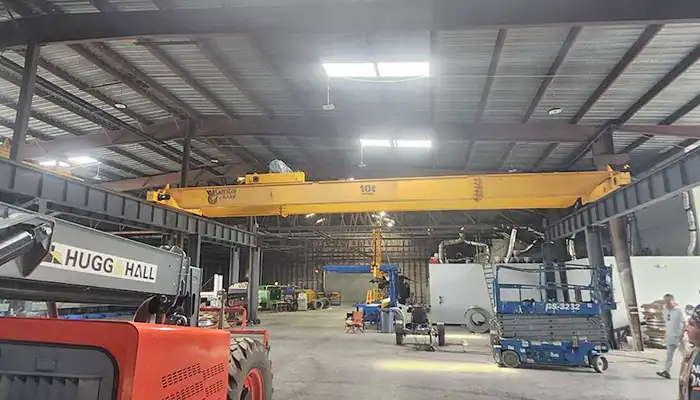
Affordable 10 ton double girder overhead crane with CD/MD hoist trolley, built for U.S. standards, ideal for construction and industrial lifting
Free consultation to Confirm Parameters & Specifications and Get
Latest Crane Price & Crane Rate.
- Types of overhead cranes : _______?
- Optional: Overhead travelling crane, goliath gantry crane,Slewing jib crane, Single girder or double girder crane,small portable crane or kbk crane, etc.
- Capacity of overhead crane: _______?
- Optional: 0.25ton, 0.5 ton, 1 ton, 2 ton, 3ton, 5 ton, 10 ton,15ton, 20ton, 25 ton, 30ton,35ton, up to 550ton, etc.
- Crane span & lifting height : _______?
- Crane travelling length : _____?
- Control of overhead crane:_______?
- Optional: pendant/ remote/cabin control
- Voltage supply of overhead crane:_____?
- Eg,: 380V50/60HZ,3Phase or others,etc.
- Application/usage of crane:_______?
- Eg,: Steel mill, ,injection mold, cement,stone, concrete,granite, general manufacturing, etc.
Just leave a message via the contact form and our hoist and crane engineer will contact you with in 24working hours.
Get In Touch
